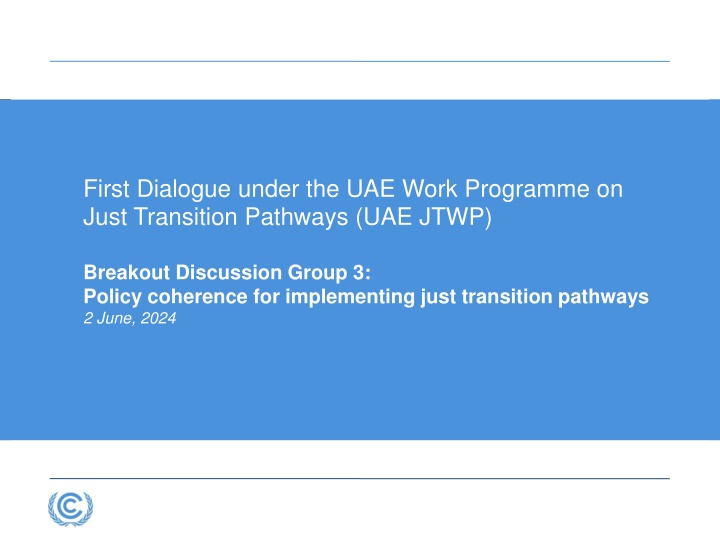Policy Coherence for Just Transition Pathways in UAE Work Programme
This dialogue focused on mainstreaming just transition pathways in NDCs/NAPs/LT-LEDS, incorporating a whole-of-government approach, ensuring coherence with national development priorities and international commitments. Key points included inclusive policy frameworks, stakeholder engagement, economic diversification, participatory planning, financial mechanisms, capacity building, transparency, and accountability.
Download Presentation

Please find below an Image/Link to download the presentation.
The content on the website is provided AS IS for your information and personal use only. It may not be sold, licensed, or shared on other websites without obtaining consent from the author.If you encounter any issues during the download, it is possible that the publisher has removed the file from their server.
You are allowed to download the files provided on this website for personal or commercial use, subject to the condition that they are used lawfully. All files are the property of their respective owners.
The content on the website is provided AS IS for your information and personal use only. It may not be sold, licensed, or shared on other websites without obtaining consent from the author.
E N D
Presentation Transcript
First Dialogue under the UAE Work Programme on Just Transition Pathways (UAE JTWP) Breakout Discussion Group 3: Policy coherence for implementing just transition pathways 2 June, 2024 3.1
GUIDING QUESTIONS: How can just transitions pathways be effectively mainstreamed in implementing NDCs/NAPs/LT-LEDS? How can a whole-of-government approach support the implementation of NDCs/NAPs/LT- LEDS that incorporate just transition pathways? How can it be ensured that these policies are coherent with national development priorities and other international commitments? 3.2
Q1: Effective mainstreaming of just transition pathways in implementing NDCs/NAPs/LT-LEDS Inclusive Policy Frameworks - Stakeholder Engagement and Policy Coherence Economic Diversification and Job Creation - Green Sectors and Social Protection Measures (unemployment benefits, healthcare, and pension schemes to support workers transitioning out of high-emission industries) Participatory Planning and Implementation Financial Mechanisms and Support - Climate Finance and Public and Private Investment Capacity Building and Awareness Raising for Policymakers - Provide training and capacity- building for policymakers to enhance understanding of the linkages between just climate action, development priorities, and international commitments. Transparency and Accountability - Mechanisms for transparency and accountability to track progress and ensure that commitments are being met. 3
Q2: Whole-of-government approach to support the implementation of NDCs/NAPs/LTLEDS that incorporate just transition pathways and policy coherence with national development priorities and other international commitments High-Level Commitment from the highest levels of government to provide political support and legitimacy to the just transition agenda Alignment with National Development Goals Just Transition and Climate policies should be explicitly linked to national development goals such as poverty reduction, economic growth, job creation, and social equity. Harmonized Regulations and Policies to avoid conflicts and redundancies, ensuring that objectives are aligned. Coherent Institutional Arrangements to ensure that climate policies and just transition principles are integrated across various sectors such as energy, transport, agriculture, labor, health and finance. Financial and Technical Support to enhance capacities for implementing just transition initiatives, including accessing climate finance mechanisms. Partnerships to mobilize resources and expertise for sustainable development projects. Facilitate ongoing dialogue with the public to build trust and support for the government's efforts. Communications and Public Awareness through strategic communication campaigns to raise public awareness about the benefits and importance of just transitions, fostering broader societal support. 4
Example: Industrial decarbonization Energy intensive industries are major contributors to climate change. E.g., steel and cement together account for 15% of the global GHG emissions. Demand for these materials is expected to grow. Achieving decarbonization of energy intensive industries requires a major system transformation based on integrated policy interventions that would facilitate: Creation of demand for low-carbon industrial products Technology collaboration between manufacturers Provision of knowledge of technology options and decarbonization pathways enabling leapfrogging in developing countries Establishment of measurement, reporting, and verification (MRV) frameworks Investment Alignment, coordination, matchmaking between different actors 6






















